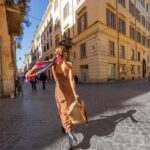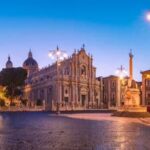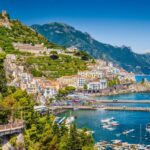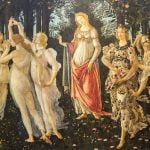The Italian Renaissance is known for its stunning art, innovative ideas, and cultural exchange. In the midst of this period, one intriguing question arises: did the Italian Renaissance painters travel to the Middle East? This inquiry opens up a captivating exploration of the historical context of travel to the Middle East during the Italian Renaissance and its influence on art.
During the Italian Renaissance, which spanned from roughly the 14th to 17th centuries, Italy experienced a flourishing of artistic, intellectual, and cultural achievements. This transformative period saw the emergence of masterful artists such as Michelangelo, Leonardo da Vinci, and Raphael, whose works continue to captivate audiences to this day. As Europe engaged in trade with the Eastern world, particularly with the Byzantine and Islamic Empires, cultural exchange and artistic inspiration flowed between these regions.
The incorporation of Middle Eastern motifs, techniques, and materials in Italian Renaissance paintings reflects this cross-cultural exchange. From intricate patterns and arabesques to exotic flora and fauna, these elements added depth and richness to artworks produced during this era. The impact of the Middle East on Italian Renaissance art is a fascinating subject that offers insight into the interconnectedness of diverse cultures and their artistic expressions.
The Italian Renaissance
Artistic Innovations
During the Italian Renaissance, there was a notable shift in artistic techniques and styles. Artists began to depict the human form with greater anatomical accuracy and emotional depth, reflecting the renewed focus on humanism. Paintings became more naturalistic and perspective was refined to create a sense of depth and three-dimensionality. These developments in art paved the way for new artistic masterpieces that continue to be celebrated to this day.
Revival of Classical Themes
One of the defining characteristics of the Italian Renaissance was the revival of classical themes from ancient Greece and Rome. Artists drew inspiration from myths, legends, and historical events depicted in ancient texts and utilized these motifs in their artworks. This incorporation of classical themes contributed to a sense of cultural continuity with the past while also allowing for creative reinterpretation and artistic expression.
Impact on Artistic Patronage
The Italian Renaissance also saw a significant change in artistic patronage. Wealthy individuals and families became prominent supporters of artists, commissioning works that reflected their own values, beliefs, and social status. This patronage system provided artists with financial stability and creative freedom to produce exceptional works of art that would shape the future of Western art history.
The Italian Renaissance not only defined a pivotal moment in art history but also laid the foundation for artistic traditions that would continue to evolve over subsequent centuries. The impact of this period can be seen in the enduring legacy of iconic artists such as Leonardo da Vinci, Michelangelo, Raphael, and Titian whose contributions have left an indelible mark on the world of art.
The Influence of the Middle East on Italian Renaissance Art
The Italian Renaissance was a period of immense artistic creativity and innovation, characterized by a revival of interest in classical art and culture. During this time, Italian artists sought inspiration from a variety of sources, including the art and culture of the Middle East. The influence of the Middle East on Italian Renaissance art can be seen in the incorporation of motifs, techniques, and materials that originated from the region.
One of the key ways in which Middle Eastern influence manifested in Italian Renaissance art was through the use of motifs and subject matter inspired by Islamic and Arab culture. This can be observed in paintings depicting scenes from biblical stories set in exotic landscapes reminiscent of the Middle East. Additionally, Italian artists often integrated elements such as intricate geometric patterns, decorative arabesques, and motifs derived from Islamic textiles into their artwork.
Furthermore, the techniques and materials utilized by Italian Renaissance painters were also influenced by their interactions with Middle Eastern art. Through trade routes and cultural exchange, artists had access to pigments, dyes, and materials such as silk that were imported from the Middle East. These materials not only expanded the artistic palette available to Italian artists but also provided them with new methods for achieving vibrant colors and intricate details in their paintings.
Overall, the incorporation of Middle Eastern motifs, techniques, and materials in Italian Renaissance art demonstrates the impact of cross-cultural exchange during this period. By embracing elements from the art and culture of the Middle East, Italian artists enriched their creative repertoire and contributed to the flourishing artistic landscape of the Renaissance.
| Italian Renaissance Art | Middle Eastern Influence |
|---|---|
| Incorporation of biblical scenes set in exotic landscapes | Islamic textiles and geometric patterns incorporated into artwork |
| Use of imported pigments and dyes from the Middle East | Expansion of artistic palette and techniques influenced by trade routes |
Exploration and Trade Routes
During the Italian Renaissance, exploration and trade routes played a crucial role in connecting Europe with the Middle East. This exchange of goods, ideas, and knowledge also had a significant impact on artistic practices in Italy. Italian artists were exposed to new materials, techniques, and motifs from the Middle East, influencing the development of their own artistic style.
Trade Routes and Cultural Exchange
The trade routes that connected Italy to the Middle East not only facilitated the exchange of goods but also allowed for cultural dialogue between the two regions. The importation of materials such as pigments, textiles, and ceramics from the Middle East introduced Italian artists to new resources that would later be incorporated into their artworks. Furthermore, the influx of Islamic art and architecture provided Italian artists with inspiration for their own creative endeavors.
Evidence of Travel
There is historical evidence suggesting that some Italian Renaissance painters did indeed travel to the Middle East in search of artistic inspiration and knowledge. Artists such as Gentile Bellini and Vittore Carpaccio are known to have journeyed to places like Constantinople (modern-day Istanbul) where they encountered Islamic art and culture firsthand. These travels not only broadened their artistic horizons but also paved the way for a rich fusion of artistic styles.
The Impact on Artistic Practice
The exposure to Middle Eastern art and culture undoubtedly left a lasting impression on Italian Renaissance painters. It is widely believed that elements such as geometric patterns, arabesques, and depictions of exotic landscapes found their way into the works of renowned artists such as Titian, Tintoretto, and Veronese. The incorporation of these motifs speaks to the cultural exchange that took place between Italy and the Middle East during this pivotal period in art history.
As we continue to uncover more about this fascinating intersection of cultures, it becomes evident that Italian Renaissance painters were not merely confined to their own local traditions but actively sought out new influences from the Middle East in pursuit of artistic growth and innovation.
Michelangelo and Leonardo Da Vinci
The potential travels of Michelangelo and Leonardo da Vinci to the Middle East have been a topic of great interest and debate among art historians. These iconic Italian Renaissance artists are known for their groundbreaking contributions to the world of art, and some scholars believe that their journeys to the Middle East may have played a crucial role in shaping their work.
While there is no concrete evidence to definitively prove that Michelangelo and Leonardo da Vinci traveled to the Middle East, many art historians have pointed to certain elements in their work that suggest a possible influence from the region. For example, both artists incorporated intricate patterns and motifs reminiscent of Middle Eastern design into their paintings and sculptures.
Additionally, they experimented with new techniques and materials that were commonly found in the Middle East, indicating a potential exposure to these artistic practices.
One of the most famous examples often cited as evidence of potential Middle Eastern influence is Leonardo da Vinci’s “The Last Supper.” Some scholars have suggested that the architectural elements and spatial composition in this masterpiece bear resemblance to designs found in Middle Eastern architecture. Similarly, Michelangelo’s use of geometric patterns and ornamentation in his sculptures has led to speculation about his exposure to Middle Eastern artistic traditions.
These theories have sparked ongoing research and discussion about the extent of cultural exchange between Italian Renaissance painters and Middle Eastern artists. While it remains unclear whether Michelangelo and Leonardo da Vinci did indeed travel to the Middle East, their innovative techniques and incorporation of diverse artistic influences continue to inspire further exploration into this intriguing subject.
| Artist | Possible Influence From Middle East |
|---|---|
| Michelangelo | Incorporation of intricate patterns and motifs similar to those found in Middle Eastern design |
| Leonardo da Vinci | Resemblance of architectural elements in “The Last Supper” to designs found in Middle Eastern architecture |
Artistic Exchange
The Italian Renaissance was a period of immense cultural and artistic exchange, with influences from the Middle East playing a significant role in shaping the artistic landscape of the time. The incorporation of Middle Eastern motifs, techniques, and materials in Italian Renaissance art is a testament to the interconnectedness of cultures during this era.
Italian Renaissance painters were known for their curiosity and eagerness to explore new artistic horizons, leading to a blending of styles and ideas from the Middle East. This fusion of styles can be seen in various artworks from the period, where elements such as intricate geometric patterns, arabesques, and depictions of exotic animals are incorporated into traditional Italian imagery.
Exploring historical evidence reveals that Italian artists did indeed travel to the Middle East in search of inspiration and artistic knowledge. These travels were often facilitated by the thriving trade routes between Europe and the Middle East, allowing for a cultural exchange that deeply impacted the art world. It is evident that these artistic exchanges played a pivotal role in shaping the development of Italian Renaissance art, contributing to its richness and diversity.
- Evidence suggests that artists such as Giovanni Bellini and Gentile Bellini traveled to Constantinople (modern-day Istanbul) as part of diplomatic missions, where they were exposed to Islamic art and culture.
- During their travels, these artists studied Islamic architecture, calligraphy, textiles, ceramics, and manuscript illumination, all of which greatly influenced their later works.
- The resulting fusion of styles can be observed in paintings such as “St. Francis in Ecstasy” by Giovanni Bellini, which features ornate arabesque designs reminiscent of Islamic art within a Christian subject matter.
It is clear that the cultural exchange between Italian Renaissance painters and Middle Eastern artists had a lasting impact on the art world, paving the way for future generations to embrace diversity and cross-cultural influences in their creative endeavors.
Modern Perspectives
In recent years, there has been a renewed interest in investigating whether Italian Renaissance painters traveled to the Middle East for inspiration and artistic knowledge. Modern scholars have utilized advanced research methods and technologies to delve deeper into this topic, leading to ongoing debates and new insights into the potential cultural exchange between Italian artists and those from the Middle East.
Current research has revealed historical evidence of exploration and trade routes that connected Italy to the Middle East during the Renaissance period. This evidence suggests that Italian artists may have had access to Middle Eastern motifs, techniques, and materials through these trade routes, influencing their artistic production. Furthermore, scholars are examining travel diaries, letters, and other primary sources to uncover any documentation of specific artists’ journeys to the Middle East.
Debates surrounding this topic have also sparked interdisciplinary collaboration between art historians, archaeologists, and experts in Middle Eastern studies. By drawing from a diverse range of expertise, researchers are gaining a more comprehensive understanding of the potential artistic exchange between Italian Renaissance painters and their counterparts in the Middle East.
This multidisciplinary approach is shedding new light on the fusion of styles and ideas that may have occurred as a result of cultural interaction during this transformative period in art history.
- Utilization of advanced research methods
- Exploration of historical evidence
- Interdisciplinary collaboration among scholars
Conclusion
In conclusion, the exploration of the potential travels of Italian Renaissance painters to the Middle East offers a deeper understanding of the cultural exchange and artistic inspiration that defined this remarkable period in art history. While there is historical evidence suggesting that Italian artists may have traveled to the Middle East for inspiration and artistic knowledge, the topic remains a subject of ongoing research and debate.
Nonetheless, it is clear that the influence of Middle Eastern motifs, techniques, and materials on Italian Renaissance art was significant, leading to a fusion of styles that enriched the artistic landscape of the era.
The impact of potential travels by iconic artists such as Michelangelo and Leonardo da Vinci to the Middle East cannot be underestimated. Their exposure to new artistic traditions and techniques may have played a crucial role in shaping their work and contributing to the evolution of Italian Renaissance art. Furthermore, the cultural exchange between Italian Renaissance painters and Middle Eastern artists undoubtedly contributed to a rich cross-pollination of ideas, resulting in groundbreaking innovations in art.
Ultimately, whether or not Italian Renaissance painters actually traveled to the Middle East does not diminish the significance of cultural exchange and artistic inspiration during this era. The incorporation of Middle Eastern influences into Italian Renaissance art reflects a spirit of openness and curiosity that transcends geographical boundaries. This period stands as a testament to the enduring impact of cultural exchange on artistic innovation, inspiring generations of artists to seek inspiration from diverse sources.
Frequently Asked Questions
Who Was the Renaissance Artist Outside Italy?
The Renaissance artist outside Italy was Albrecht Dürer, a German painter, printmaker, and theorist from Nuremberg. He is known for his high-quality woodcuts and copper engravings that helped spread Renaissance ideals in Northern Europe.
Who Spread the Renaissance Outside of Italy?
The spread of the Renaissance outside Italy can be attributed to the Northern European countries like Germany, France, and the Netherlands. Artists and scholars in these regions were influenced by Italian Renaissance ideas and incorporated them into their work, contributing to the spread of the movement.
Where Do Most Renaissance Painters Come From?
Most Renaissance painters come from Italy, which was the birthplace of the Renaissance movement. Cities like Florence, Rome, and Venice were hubs of artistic activity during this period, producing renowned painters such as Leonardo da Vinci, Michelangelo, Raphael, and Titian. However, as the movement spread, artists from other European countries also began to embody Renaissance principles in their work.

I’m a passionate traveler, writer, and Italophile. My fascination with Italy’s history, art, and culture has led me on countless adventures across the Italian landscape. Through “I Live Italy,” I share my love for this extraordinary country and aims to inspire others to explore its boundless beauty.





